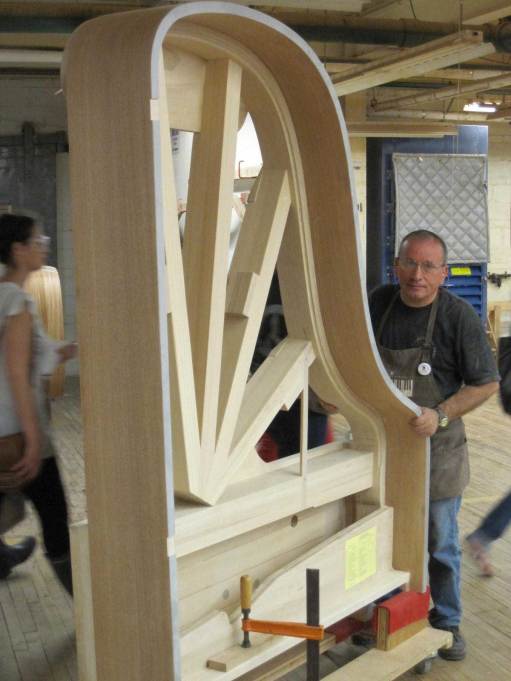By Philip I. Rosenbaum
Associated Press Writer
NEW YORK (AP) – Waging a tug of war with the laws of physics, six barrel-chested men bend and hammer a 600 pound wedge of laminated rock maple into the curvy shape of a Steinway piano. Working without power tools, the men known as “rim benders” struggle for 10 minutes as they pry the wood into a big vice that will mold it into the frame of a $60,000 concert grand.
 Rim bending – developed and patented by Steinway & Sons more than a century ago – is one of thousands of steps taken before a piano rolls out of a factory in the New York City borough of Queens.
Rim bending – developed and patented by Steinway & Sons more than a century ago – is one of thousands of steps taken before a piano rolls out of a factory in the New York City borough of Queens.
The 10-acre plant looks more like a huge, high school wood shop than a modern factory, with lathes and drills dotting the floor. Steinway’s craftsmen turn out about 2,500 pianos a year, compared with tens of thousands produced by competitors Baldwin and Yamaha.
Steinway takes about a year to make each instrument, composed of more than 12,000 working parts, including a 340-pound cast iron plate. With another 2,000 pianos made each year at its second factory in Hamburg, Germany, Steinway controls only a 1 percent to 2 percent share of the world market.
One reason Steinway remains small is that sections of the New York plant date to the 19th century.
“The practical fact is we couldn’t produce a huge number of pianos even if we wanted to,” said Bruce Stevens, Steinway’s president. Stevens and two other businessmen bought Steinway in 1985 from CBS, which owned it for 13 years.
Founded in a Manhattan loft in 1853 by German immigrant Heinrich Engelhard Steinweg, Steinway boasts that 90 percent of concert pianists play its pianos.
But in the last few decades the piano industry has seen business dwindle. Worldwide shipments from factories fell to approximately 100,000 in 1992 from a peak of about 282,000 in 1978, says the Piano Manufacturers Association International, which represents most makers.
A profusion of high-tech consumer goods developed over the last few decades has weakened people’s desire to tickle the ivories, said Donald W. Dillon, executive director at the Dallas-based association.
“Folks who have disposable income are buying computers and audio and video equipment,” Dillon said. “People just don’t gather around the piano like they used to.” Also, the growing electronic keyboard industry is eroding acoustic piano sales, he said.
But the attrition comes at the expense of cheaper verticals, not grand pianos, the core of Steinway’s business, Stevens said, adding that Steinway sales have been fairly steady for years.
The privately held company does not disclose sales or revenues.
At Steinway, change comes slowly. The company is careful about protecting the traditions that make it an esteemed name, said Bill Youse, manager of shop operations in the restoration department and frequent tour guide.
“You don’t bounce around from job to job here,” Youse said. “If you begin on a job and you’re good at it, you stay there.”
Youse, a polisher for six years, provides a personal example. He developed an allergy to the chemicals but stayed on that job until he learned a new skill and Steinway found a replacement.
“This isn’t the kind of business where you say, ‘We’re going to hire four piano action rebuilders.’ You don’t hire them from the newspaper. You don’t find them at an employment agency. You’ve got to train these people.”
Yet Steinway keeps up with changing technology as long as quality isn’t sacrificed, Youse says.
In one area of the factory, a $ 500,000 computer-operated machine cuts parts in a fraction of the time it took workers. Nearby, handsaws and sandpaper are still used.
“People expect to come to Steinway and see a little man in a leather apron making a piano from a hollow tree,” Youse said. “But that’s not the way it is. We’re looking for the perfect marriage between artistry and technology.”
One bold experiment with change gave Steinway a scare. In the early 1960s, Steinway began using Teflon in hundreds of tiny bushing covers instead of felt, which is damaged by humidity.
Teflon’s weakness was that a few years’ wear caused a heavy, uneven action that made a clicking noise. Moreover, most piano technicians were not trained in repairing Teflon bushings.
Pianists caught the problem and began deserting Steinways for other makes, or demanding Steinways made in the Hamburg factory, which never experimented with Teflon.
Steinway, which was going through several changes of ownership during that time, capitulated and dumped the Teflon parts in 1981.
Franz Mohr, who tuned Steinways for concert greats such as Vladimir Horowitz for 25 years, said the change to Teflon caused the biggest crisis he ever saw Steinway endure.
“It gave us for a while quite a bad reputation,” he said.
